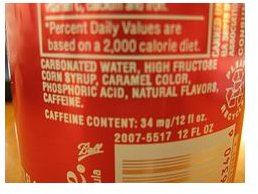Metabolizing High Fructose Corn Syrup - The Relationship between Soda and Abdominal Fat
Fructose is a natural sugar found primarily in fruits and high fructose corn syrup (HFCS). Sodas, sports drinks, energy drinks, sweetened teas, and most other commercial beverages are sweetened with HFCS because it is a cheap source of sugar. But can HFCS have unexpected effects on your body?
Fructose Sweetened Beverages, Abdominal Fat, and Cholesterol
Dietary researchers have long known that consuming a large amount of fructose in the diet causes problems with blood cholesterol and triglyceride levels. In one study, overweight and obese people who consumed 25% of their calories as fructose-sweetened beverages for 10 weeks saw their triglycerides and LDL (“bad”) cholesterol levels rise. A control group that consumed a different kind of sugar, glucose, did not have these problems. In addition, the people who drank fructose-sweetened beverages had an increase in their belly fat. High triglycerides, high LDL cholesterol, and excess abdominal fat are all known risk factors for heart disease.
Fructose (and high fructose corn syrup) contain no fat or cholesterol. Instead, the body changes the sugar into fat, triglycerides, and cholesterol. The difference between the effects of fructose and glucose have to do with how the body handles each of these sugars.
How Much Soda: Keeping HFCS in Perspective
To get the negative effects such as increased stomach fat and higher cholesterol, studies have shown that a person has to consume about 20-25% of their calories as fructose. That’s a lot of sugar. People who take in less fructose, around 4-12% of their calories, did not have these effects.
The high fructose corn syrup used to sweeten sodas and other beverages contains about 55% fructose and 45% glucose. A 22-ounce soda contains about 280 calories (cola) to 400 calories (lemon lime soda). If the drink is sweetened with high fructose corn syrup, the number of these calories that come from fructose is about 150-220. A person on a 2,000 calorie diet would have to drink two 22 oz. lemon lime sodas or three 22 oz. colas daily to get 20-25% of their calories from fructose. For a 2,500 calorie diet, it would take about two and a half lemon lime sodas or three and a half colas. For a 3,000 calorie diet, it would take about three lemon lime sodas or four colas.
Can Soda Make You Fat? The Bottom Line
Soda and other sweetened beverages can cause weight gain simply because of the calories they contain. The special risk of increased belly fat (linked to heart disease) that has been shown in studies would require a person to drink a large amount of these drinks. If you spend all day with a soda or an energy drink in your hand, you should consider cutting back your intake. Doing so could cut your risk of heart disease by lowering triglycerides, LDL cholesterol, and abdominal fat, and may even save your life.
References & Credits
- E. J. Schaefer, J. A. Gleason, and M. L. Dansinger. “Dietary Fructose and Glucose Differentially Affect Lipid and Glucose Homeostasis.” Journal of Nutrition e-published 2009 Apr 29.
- K. L. Stanhope et al. “Consuming fructose-sweetened, not glucose-sweetened, beverages increases visceral adiposity and lipids and decreases insulin sensitivity in overweight/obese humans.” Journal of Clinical Investigation 2009 May;119(5):1322-34.
- Photo by Peter Krefting (click on image for a larger view).
This post is part of the series: High Fructose Corn Syrup - The Dangers of HFCS & Foods that Contain It
High fructose corn syrup (aka HFCS, glucose-fructose and isoglucose) has been replacing sugar in several processed foods across the nation. Unfortunately, there are dangers of high fructose corn syrup. Learn what some of these dangers are and which foods contain HFCS in this article series.
